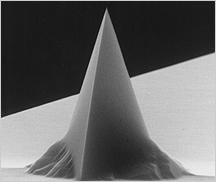
Soft Tapping Mode AFM Probe
NanoWorld Pointprobe® NCSTR AFM probes are designed for non-contact or soft tapping mode imaging. The combination of soft AFM cantilever and fairly high resonance frequency enables stable and fast measurements with reduced tip-sample interaction. Thus, AFM tip and sample wear could be significantly decreased.
All SPM and AFM probes of the Pointprobe® series are made from monolithic silicon which is highly doped to dissipate static charge. They are chemically inert and offer a high mechanical Q-factor for high sensitivity. The AFM tip is shaped like a polygon based pyramid.
Additionally, this AFM probe offers an excellent tip radius of curvature.
For applications requiring lower resonance frequencies or a AFM cantilever length exceeding 150 µm use NanoWorld Pointprobe® type NCLR. For standard non-contact / tapping mode application use NanoWorld Pointprobe® type NCHR.
This AFM probe features alignment grooves on the back side of the holder chip.
